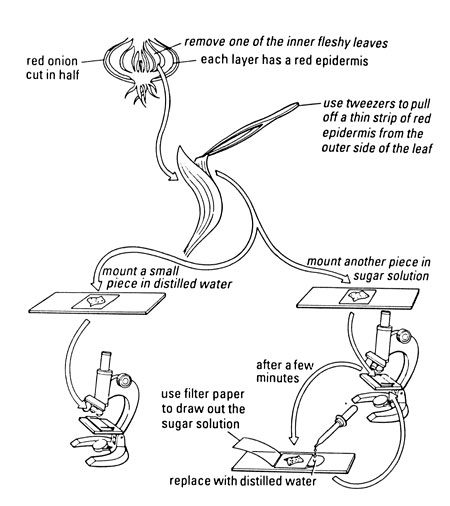Observing osmosis, plasmolysis and turgor in plant cells
Class practical or demonstration
A single layer of plant cells is placed on a microscope slide and either distilled water or 5% sodium chloride solution is added to the cells. Osmosis will occur resulting in either turgid cells or plasmolysed cells.
Lesson organisation
This activity could be carried out by students working as individuals or in pairs, depending on the number of microscopes available. Or small groups could use different concentrations of sodium chloride solution, and the students could inspect one another’s slides. If you have access to only one microscope and a video camera you could project the images for all to see.
Apparatus and Chemicals
For each group of students:
Microscope
Microscope slides, 1 per specimen
Cover slips, 1 per specimen
Distilled water
Salt solution (sodium chloride) 5% w/v
Teat pipettes
Forceps
Pieces of filter paper
For the class – set up by the technician/ teacher:
Red onion, cut into slices approximately 1 cm wide, 1 or 2
Alternatives:
- Rhubarb stem
- Ivy-leaved toadflax (Cymbalaria muralis)
- Cladophora (a filamentous alga)
Video microscope (if available)

Health & Safety and Technical notes
Onion may irritate some students’ eyes to the point of discomfort.
Take care with microscope slides and (especially) cover slips which are fragile and break easily. Ensure students know how to deal with broken glass.
Sodium chloride is described as ‘low hazard’ on Hazcard 47B.
1 Use fresh onions; as it is more difficult to peel a single layer of cells from an old onion.
If you cannot peel a layer of cells using forceps, hold a piece of onion with the red cells facing towards you and fold the tissue in the same way as closing a book. This will break the white tissue but not the red tissue. Peel off the white tissue and you should get a thin line of intact red cells on the fold line. Cut these off and mount.
2 To get an epidermal strip from toadflax; hold the leaf so the lower epidermis is facing you, stalk pointing downward. Fold the top section of leaf down and crease so upper layers of leaf break, but not the lower epidermis. Peel the top section down and to the right. This should give you a single layer of pale pink lower epidermal cells. Cut this off and mount.
Ethical issues
There are no ethical issues with this investigation.
Procedure
a If you are using a red onion cells, cut a 1 cm square of onion. Then peel off a single layer of the red cells from an inner fleshy leaf of the onion. (See note 1.)
b If you are using rhubarb, peel a piece from the epidermis.
c If you are using toadflax peel a piece of the lower epidermis of a leaf. (See note 2.)
d Place the strip on a slide. Cover it with a drop or two of distilled water. Add a cover slip.
e Look at the cells through a microscope, starting with the low power lens.
f Take another strip of cells from your plant material. This time mount the cells with a couple of drops of 5% sodium chloride solution.
g Examine through the microscope and compare the cells to those mounted with distilled water.
h After a few minutes draw out the sodium chloride solution with a piece of filter paper placed at the edge of the coverslip. Replace it with distilled water added at the other side of the coverslip.
i See what happens to the cells.
Teaching notes
This experiment could be run as a qualitative investigation of the effects of water and sodium chloride solution on the contents of plant cells.
You can make the investigation quantitative by using different concentrations of sodium chloride solution (e.g. 0%, 1%, 2%, 3%, 4%, 5%). Students can count how many of a fixed number of cells are plasmolysed at each concentration. You can calculate the percentage of plasmolysed cells and plot a graph of percentage plasmolysis against sodium chloride concentration.
Cells are plasmolysed (plasmolysis has occurred) when the cell contents shrink and come away from the cell wall. The student sheet introduces the word, but does not require them to use it, so you do not need to explain this term unless it is relevant to your students.
Health and safety checked, September 2008
Downloads
Download the student sheet ![]() Observing osmosis, plasmolysis and turgor in plant cells (105 KB) with questions and answers.
Observing osmosis, plasmolysis and turgor in plant cells (105 KB) with questions and answers.
Related experiments
Investigating osmosis in chickens’ eggs
Investigating the effect of concentration of blackcurrant squash on osmosis in chipped potatoes


